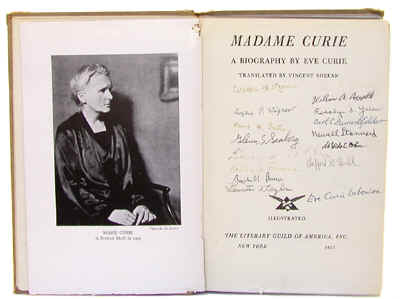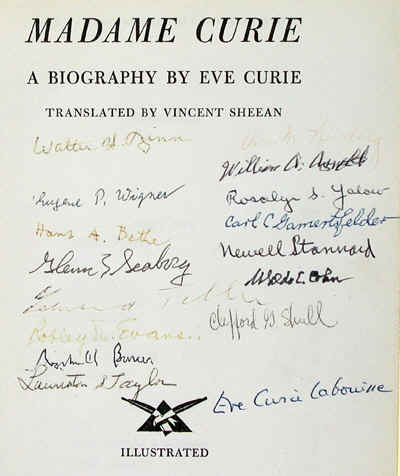Autographed Biography of Marie Curie
This is a copy of the first English edition (1937) of Marie Curie's biography written by her daughter Eve.

The autographs in the first column are, in descending order:
Walter Zinn, Eugene Wigner, Hans Bethe, Glenn Seaborg, Edward Teller, Robley Evans, Marshall Brucer, Lauriston Taylor.
The autographs in the second column are, in descending order:
Alvin Weinberg (faded), William Arnold, Rosalyn Yalow, Carl Gamertsfelder, Newell Stannard, Waldo Cohn, Clifford Shull and the author, Eve Curie-Labouisse

Walter Zinn (1906-2000)
Director Argonne National Laboratory 1946-1956. Assisted Enrico Fermi in construction of first nuclear reactor CP-1. In charge of preparing materials for CP-1, and along with Herbert Anderson oversaw its construction. Designed control rod "ZIP" for CP-1. Designed Experimental Breeder Reactor I, first reactor to produce electricity on a significant scale.
Eugene Wigner (1902-1995)
Nobel Prize in Physics in 1963. Quoting the presentation speech by I. Waller: "In order to be able to calculate the motion of the nucleons it was... necessary to know also the forces which act between them. A very important step in the investigation of these forces was taken by Wigner in 1933 when he found, deducing from some experiments, that the force between two nucleons is very weak except when their distance apart is very small but that the force is then a million times stronger than the electric forces between the electrons in the outer part of the atoms. Wigner discovered later other important properties of the nuclear forces...
This work by Wigner and his other investigations of the symmetry principles in physics are important far beyond nuclear physics proper. His methods and results have become an indispensable guide for the interpretation of the rich and complicated picture which has emerged from recent years' experimental research on elementary particles."
Hans Bethe (1906-2005)
Nobel Prize in Physics in 1967. His main field of study involved nuclear reactions. Bethe discovered the reactions which provide the source of energy in stars. He is said to have laid the foundation for modern quantum electrodynamics. During the Manhattan Project in WW II, he headed up the theoretical physics division at Los Alamos. He participated in the negotiations that resulted in the 1963 partial test ban treaty with the Soviet Union.
Glenn Seaborg (1912-1999)
Nobel Prize in Chemistry in 1951. Discoverer or co-discoverer of ten elements (plutonium, americium, curium, berkelium, californium, einsteinium, fermium, mendelevium, nobelium and seaborgium), and dozens of radionuclides (e.g., Cs-137, Co-60, I-131). He developed the concept of the actinide series which he positioned underneath the lanthanide series on the periodic table. Seaborg actually held patents on the elements americium and curium. Chairman of the US Atomic Energy Commission (1961-1971).
Edward Teller (1908-2003)
Director of Lawrence Livermore National Laboratory from 1958 to 1960. Primary field of interest was quantum and nuclear physics. Together with George Gamow developed "Gamow-Teller" rule for beta emission. During WW II at Los Alamos, he began working on a bomb employing thermonuclear fusion. He is often considered to be the father of the H-Bomb, a title that irritated him.
Robley Evans (1907-1995)
Quoting from the 1995-96 calendar produced by the Health Physics Society: "At the Massachusetts Institute of Technology, Evans built the first whole body counter to measure radium uptake by the radium dial painters and carried out the first quantitative in-vivo measurements of a radionuclide in the human body. Indeed, the scintillation cameras so common in today's hospitals are direct descendants of his original counter. Evans' studies went well beyond measuring radium in the body: he pioneered investigations into its metabolism, its hazards, and methods for mitigating these hazards. He was primarily responsible for promulgating the first limit on radioactive material in the body, 0.1 uCi of radium-226, a value that served for more than four decades as the benchmark for bone-seeking radionuclides. Not the least of his contributions was the first use, (ca. 1930s) of radioiodine to evaluate thyroid function in humans, which is a technique that stood the test of time and remained, well into the 1980s, one of the most potent diagnostic tools available to physicians. It is no wonder Robley Evans is recognized as one of the founders of the field of Nuclear Medicine.
Marshall Brucer (1913-1994)
First chairman of the Medical Division of the Oak Ridge Institute of Nuclear Studies (ORINS), now ORAU. First president of the Society of Nuclear Medicine. Brucer invented "mock-iodine" and in the 1950s almost single handedly oversaw the international inter-laboratory calibrations of thyroid uptake instrumentation. Along with Leonard Grimmet, Brucer conceived the idea of, and designed, the first cobalt-60 teletherapy unit. Grimmet died before the unit was constructed (the first Co-60 unit to actually operate was Canadian). Brucer built the first Cs-137 teletherapy unit.
Lauriston Taylor (1902-2004)
In 1928 Taylor accepted a position with the National Bureau of Standards and within a year, served as the Bureau’s representative at the Second International Congress of Radiology in Stockholm. At the conference, Taylor , along with four others, founded what is now the International Commission on Radiological Protection (ICRP), an organization with which he would serve in various capacities, and an organization with which he would retain an association longer than any of the other original members. A year later, in 1929, he founded and became Chairman of what would become the National Committee on Radiation Protection (NCRP). He retained the chairmanship until 1964 when the organization became the National Council on Radiation Protection and Measurements and his title was changed to President, a position he held until 1977. Among his many accomplishments, he made significant improvements to the design of the free air chamber and helped standardize international measurements of exposure (the roentgen).
Alvin Weinberg (1915-2006)
During his WW II work with the Manhattan Project in Chicago, Dr. Weinberg assisted Enrico Fermi in the design of CP-1 (the first nuclear reactor to achieve self-sustaining criticality) by determining the optimal spacing for the fuel elements. He subsequently made a similar contribution to the design of the Oak Ridge Graphite Reactor. In 1958 he and Eugene Wigner co-authored what has come to be the standard text on reactor theory—the “Physical Theory of Neutron Chain Reactions.” He is probably the single individual most responsible for the development of pressurized water reactors, and showed Hyman Rickover how such reactors could power a nuclear navy. Among his other accomplishments: he served as director of Oak Ridge National Laboratory, made the original proposal for the formation of the American Nuclear Society and coined such terms as “technological fix”, “nuclear priesthood” and “big science.”
William Arnold (1904-2001)
Discovered the electronic nature of energy transfer in photosynthesis. Coined the term "fission" as it applies to the splitting of a nucleus. For the story behind this event, as well as some other stories, click here.
Rosalyn Yalow (1921-2011)
Nobel Prize in Medicine in 1977. Developed the technique of radioimmunoassay, a test that permits the measurement of hormones, enzymes and other substances that are present in what had otherwise been immeasurably low levels.
Carl Gamertsfelder (1913-1996)
Second individual, after Ernest Wollan, to use the title "Health Physicist." Was the only health physicist actually present when CP-1 achieved the first self-sustaining criticality.
Newell Stannard (1910-2005)
Established the world's first PhD program in radiation biology at the University of Rochester. His primary fields of research were the physiological effects of radiation in cells and the biological effects of alpha emitting radionuclides. Author of "Radioactivity and Health: A History."
Waldo Cohn (1910-1999)
Quoting Alvin Weinberg: "The main task (in 1943) [in the Manhattan Project activities at Clinton Labs] was to produce gram quantities of the nuclear explosive, plutonium. The techniques developed there were transferred to the huge plutonium-producing nuclear reactors at Hanford, Wash.
"To manufacture plutonium, one had to 'cook' uranium in an atmosphere of neutrons in the nuclear reactor at Clinton Lab. In this process uranium atoms were split to create radioactive 'fission products.' Cohn set about to identify the chemical species of fission products. He applied to this process a technique known as 'ion exchange chromatography.'
"After the war Cohn realized that this technique could be applied to the characterization of the components of the nucleic acids, DNA and RNA. Cohn's technique ultimately led to Crick and Watson's structure of the genetic materials, DNA and RNA. For this achievement Cohn received the Chromatography Award of the American Chemical Society and he was named a fellow of the American Academy of Arts and Sciences.
"Cohn was also the first to organize and promote the use of radioactive radioisotopes produced in nuclear reactors. The widespread use of radioisotopes is perhaps the most important scientific byproduct of the Manhattan Project."
Clifford Shull (1915-2001)
Nobel prize in Physics in 1994. Working with Ernest Wollan at Oak Ridge National Laboratory, Shull developed the technique of neutron diffraction analysis. This technique permits the location of atoms in a material to be determined by observing the scattering patterns of neutrons striking the material.
Eve Curie-Labouisse (1904-2007)
Best known for her biography of her mother, Marie Curie. She also wrote "Journey Among Warriors" in which she described her experiences during World War II.
In 1940, Eve Curie moved to England to assist the Allied cause. In 1952, she was appointed Special Adviser to the Secretary General of NATO and served on its International Staff. She also served as Executive Director of the United Nations Children's Fund. In 1954, she married Henry R. Labouisse. Unlike her parents and her sister Irene, Eve did not follow the path of science.
Glenn Seaborg and Marie Curie
Precious items in the collection include a security badge worn by Nobel Prize-winning chemist Glenn Seaborg when he visited Oak Ridge in 1944, and a first edition book written by Marie Curie signed by a number of famous scientists.
